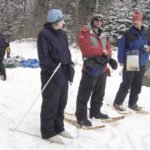Somewhere in northern Minnesota, there is a pile of apples with a deer stand over yonder. Somewhere else, there is a pile of corn hidden beneath the bows of a balsam tree so the game wardens can’t see it from the air. Stealthier still, beneath a third deer stand, someone scattered black oiler sunflower seeds, which are even more difficult to detect. Spreading bait to attract deer to a hunting location may be against the law in Minnesota, but out in the woods and on the back forty, it persists.
Minnesota banned deer baiting 20-some years ago, hoping to outlaw the practice before it spread throughout the state’s deer-hunting community. At the time, DNR officials thought baiting was most common in the Duluth area, where hunters picked up the habit from their Wisconsin brethren, who had been legally doing it for a number of years. Baiting was so widespread on Michigan’s Upper Peninsula that apples, corn and other deer foods were available by the truckload at rural convenience stores.
At the time, Minnesota’s baiting ban was controversial, though the scale of controversy pales in comparison with today’s DNR woes. Pro-baiters had a litany of “reasons” for why they needed to hunt over bait. For starters, it was only fair, because hunters in agricultural regions could hunt near cornfields. In the Northwoods, where deer are sometimes sparse, baiting gave you a better chance of seeing one. Besides, you can use bait for bear or when fishing, so what’s the big deal?
Minnesota wildlife officials stuck to their guns. When I reported on the topic, they said wildlife managers in Wisconsin and Michigan warned them that once baiting takes hold, it brings about profound changes to deer and deer hunting. Hunters compete to see who can put out the most bait, creating a situation where whitetails congregate near the largest bait piles, eating there and sleeping nearby. This disrupts natural deer movements. The well-fed deer often restrict their activity until after dark. Deer feeding in close company at a bait pile face an increased risk of becoming infected with contagious illnesses. This puts the health of the deer population at risk. When baiting becomes the prevalent method for shooting deer, it isn’t long before an entire generation of young hunters know of no other way to kill deer. This puts the traditions and future of deer hunting at risk.
In Minnesota, bait is defined as food you place out for deer. You can still put out mineral blocks as licks, plant a patch of turnips or some other crop and hunt over it, or anoint yourself or the area around your hunting stand with deer urine and manufactured scents intended to attract whitetails. Nonetheless, some scofflaws still feel the need to dump out bait. Citations for illicit baiting have been the most common deer hunting violation in the state for years. Conservation officers say baiters go to great lengths to carry out their dirty business. In addition to concealing their bait sites, some poachers (that’s what they are) will even use cheap guns rather than risk confiscation of an expensive rifle if they are caught. Even the loss of hunting privileges for a period of years doesn’t deter them. Sometimes, officers even arrest repeat offenders.
Whether baiting makes it easier to kill a deer than by legal means is a matter of debate. What is clear is that the people who are willing to risk arrest by placing bait near their deer stand think it does. But another explanation may be that they either have no knowledge of legal hunting methods or lack the confidence to use them.
Because once law-abiding hunters will refuse to give up baiting, even when they risk arrest and serious legal consequences, some wildlife officials refer to it as an addiction. Perhaps it is. At the very least, it is example of behavior where someone places their own satisfaction above all else. A baiter not only takes a chance with encountering law enforcement, but they are willing to diminish the hunting opportunities of other hunters by disrupting natural deer movements and chance the spread of deer diseases by encouraging the animals to congregate at a bait.
In light of what we’ve learned about Chronic Wasting Disease, the latter is a chance no responsible person should take. We know CWD is spread by close contact among deer and that it is always fatal. We’ve also seen, from the grim experience of Wyoming and Wisconsin, that once CWD takes hold in a local or regional deer population, it infects a significant percentage of the animals. We are learning, in light of new research, that CWD can be transmitted to other species that eat infected meat, possibly including humans.
While I do my best to avoid such situations, I recently got into a Facebook discussion with an Ontario hunter on the topic of baiting. Immediately north of the Minnesota border, baiting, which is legal there, seems to have caught on in a big way in recent years. Not only are hunters dumping apples by their stands, but some are even using timed feeders, which are set to broadcast bait when the timer goes off. At least one new hunter of my acquaintance, following the lead of informal hunting mentors, has taken to hunting over an apple pile as the preferred way to kill a deer.
The Facebook discussion followed a predictable path. I was told hunters in agricultural areas hunt over thousands of acres of bait called cornfields. Because farmland deer are far more numerous than whitetails in the North, northern hunters have a tougher seeing deer and thus filling their tag. I also was told that CWD doesn’t exist in northwestern Ontario and that it is primarily spread via deer farming, rather than wild animals attracted to bait piles.
All of those statements are true, but a basic fact of baiting remains. Once they start baiting, many, if not most, hunters start to rely on it as their primary method to shoot a deer. Baiting is also passed on to hunters new to the fold, doing them, and the future of deer hunting, a great disservice. You don’t need to know much about the ways of whitetails or hunting to shoot one at a bait pile. Sadly, you may never develop the passion for the hunt and for wildlife conservation, that has defined hunters for more than a century. And that is really too bad.



